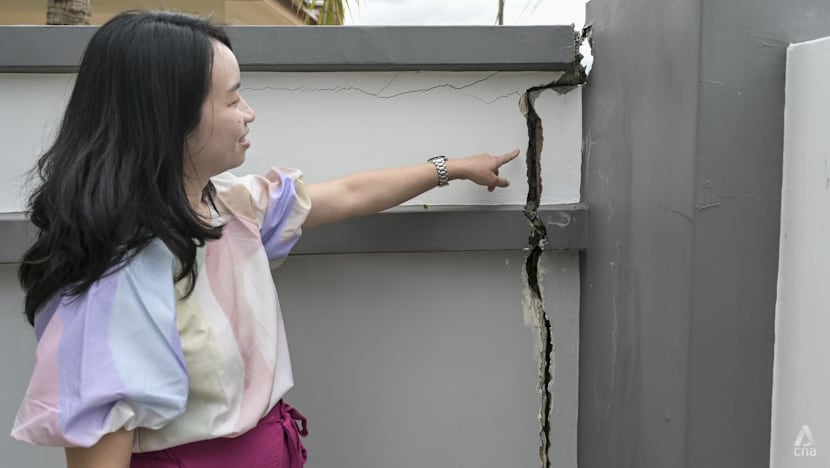6 states in Malaysia at risk of earthquakes, says deputy minister
According to a study by Malaysia’s Department of Mineral and Geoscience, Pahang, Terengganu, Perak and Negeri Sembilan in Peninsular Malaysia as well as the Borneo states of Sabah and Sarawak were identified as areas at risk of earthquakes.

KUALA LUMPUR: Following a series of minor earthquakes that have struck Johor over the past two months, a study conducted by a Malaysian government geological agency found that six states in the country have been identified to be at risk of the natural disaster.
These are Pahang, Terengganu, Perak and Negeri Sembilan in Peninsular Malaysia as well as the Borneo states of Sabah and Sarawak. Malaysia has a total of 13 states and three federal territories.
Deputy Minister of Natural Resources and Environmental Sustainability Huang Tiong Sii told Parliament on Monday (Oct 6) that studies conducted by the Department of Mineral and Geoscience (JMG) had - through active fault mapping and the Malaysian seismotectonic map - found fault zones in these six states vulnerable to seismic activity.
A seismotectonic map is a specialised geological map that integrates data about a region's tectonic activity, seismic history, and faults to help understand and predict earthquake hazards.
In relation to the study conducted by JMG, Huang said that the Malaysian Seismic Hazard Map - which is developed by the agency in collaboration with MetMalaysia, local universities and other related technical agencies - is currently being updated.
“The update takes into account the latest data, including recent earthquake events, the presence of active faults, geological materials and soil investigation findings,” Huang said on Monday.
He was responding to a question by Member of Parliament for Sri Gading Aminolhuda Hassan about studies by MetMalaysia and JMG to determine the cause of recurring minor earthquakes in Segamat and Batu Pahat in the southern state of Johor, as well as efforts to identify other areas that may face similar risks.
A series of earthquakes struck Johor in late August, with magnitudes ranging from 2.5 to 4.1.
The most recent one of 3.5 magnitude occurred 25km southeast of Batu Pahat at a depth of 10km on Sep 27.
Experts have linked these quakes to the Mersing Fault Zone.
Although the quakes have been relatively mild, residents in several districts, including Segamat, Yong Peng and Kluang, had previously reported feeling the ground shake.
“The earthquakes in Segamat and Batu Pahat were part of a natural process releasing accumulated tectonic energy within ancient fault lines to stabilise the earth’s crust. This was influenced by the extension of the Mersing Fault Zone, a major fault system in East Johor,” Huang told Parliament on Monday, as quoted by local news outlet Malay Mail.
“Based on the current and updated data, Segamat and Johor as a whole remain within a safe zone.”
He added that MetMalaysia and JMG are working together to monitor seismic activities across the country to ensure a more effective early warning and disaster response system.
“To achieve this, MetMalaysia will implement phase two of the earthquake and tsunami service enhancement project under the 13th Malaysia Plan,” he said, as quoted by Free Malaysia Today.
The second phase of the project would include strengthening 12 seismic stations nationwide, building two new stations in Segamat and Muar in Johor as well as upgrading four existing stations in Johor Bahru, Batu Pahat and Gelang Patah from strong-motion to weak-motion types to detect low-magnitude tremor, Tiong said.
State news agency Bernama previously reported that the federal government had approved a RM3 million (US$712,000) budget allocation to build the two seismic stations in Johor.
In response to a supplementary question from Rompin MP Abdul Khalib Abdullah regarding the maximum possible earthquake magnitude that could strike Johor, Huang said that studies by a seismometric working group found that Segamat and Batu Pahat will see moderate-intensity earthquakes at most, reported Free Malaysia Today.
According to Malay Mail, the seismic working group comprised technical agencies, researchers and professional bodies under the Earthquake Action Committee led by JMG.
While earthquakes in Peninsular Malaysia are generally of weak to moderate intensity, there remain risks, especially in areas close to fault zones, such as the Mersing Fault Zone, Huang said.
Geological experts told CNA previously that these earthquakes in Johor serve as a reminder that Peninsular Malaysia, Singapore and the surrounding region are not immune to the natural disaster that could trigger severe tremors and inflict damage to people and property.
















